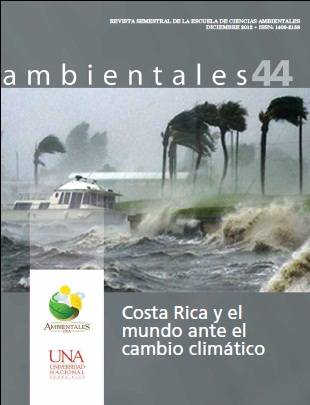Extreme Hydrometereological Events in Costa Rica from the Perspective of Adaptation to Climate Change
DOI:
https://doi.org/10.15359/rca.44-2.1Keywords:
Extremes events, weather variability, climate change, adaptationAbstract
The indirect effects from a Caribbean hurricane, low pressure systems and cold fronts, are the Extreme Hydrometeorological Events (EHE) that cause greater impacts due to excessive rains in Costa Rica. Hurricanes are the events that individually generate more precipitation. The highest frequency is between september and november and its impacts are in the Pacific side. Cold fronts are the most common phenomena. Usually, they are concentrated between december and january and impact the northern and the Caribbean regions. The low pressure system occurs between April and November and its effects can be felt in the Caribbean and the Pacific. Cold fronts tend to decrease. That means progressive drier scenarios in the Caribbean and Northern Region between november and february. The low pressure systems and hurricanes in the Caribbean, also tend to decrease, but the trend of the past 30 years shows a slight increase. These features of the EHE should be the basis for adaptation strategies.
References
Aguilar, E., Peterson, T., Ramírez, P., Frutos, R., Retana, J., Solera, M., Soley, J., González, G., Araujo, R., Santos, R., Valle, V., Brunet, M., Aguilar, L., Alvarez, L., Bautista, M., Casta-ón, C., Herrera, L., Ruano, E., Sinay, J., Sánchez, E., Hernández, G., Obed, F., Salgado, J., Vázquez, J., Baca, M., Gutiérrez, M., Centella, C., Espinoza, J., Martínez, D., Olmedo, B., Ojeda, E., Nú-ez, R., Hayloch, M., Benavides, H. y Mayorga, R. (2005). Changes in precipitation and temperature extremes in Central America and northern South America, 1961-2003. Journal of Geophysical Research, Vol 110: D23107. http://dx.doi.org/10.1029/2005JD006119
Alfaro, E. y Quesada, A. (2010). Ocurrencia de ciclones tropicales en el mar Caribe y sus impactos sobre Centroamérica. InterSedes: Revista de las sedes regionales, Vol 11: 22, pp. 136-153. San José: Universidad de Costa Rica.
Alfaro, X. (17-02-2012). Tomás dejó las pérdidas más grandes de la historia. La Nación. Sección El País.
Alvarado, L., Contreras, W. y Jiménez, S. (2011). Escenarios de Cambio Climático regionalizados para Costa Rica. Departamento de Climatología e Investigación Aplicada. Instituto Meteorológico Nacional. 43p.
CNE. (2010). Plan Nacional para la Gestión del Riesgo 2010-2015. Marco estratégico para la aplicación de la política de gestión del riesgo. San José. 82p.
Flores, R., Salas, J., Astorga, M. y Rivera, J. (2010). Impacto económico de los eventos naturales y antrópicos extremos en Costa Rica. 1988-2009. Ministerio de Planificación Sectorial y Política Económica. San José. 32p.
Houghton, J., Ding, Y., Griggs, D., Noguer, M., Van der Linden, P. y Xiaosu, D. (2001). Climate Change 2001: The scientific basis. Contribution of Working Group I to the Third Assessment Report of the Intergovernmental Panel on Climate Change (IPCC). United Kingdom: Cambridge University Press. 944p.
IPCC. (2007). Cambio climático 2007. Base de las ciencias físicas. Resumen para responsables de políticas. Resumen técnico. Preguntas frecuentes. Contribución del Grupo de Trabajo 1 al Cuarto Informe de Evaluación. OMM-UNEP. 153p.
IMN-CRRH. (2008). Clima, Variabilidad y Cambio Climático en Costa Rica. Segunda Comunicación Nacional sobre Cambio Climático. San José: IMN-CRRH-Minaet-PNUD. 75p. [Autores: Retana, J.; Alvarado, L.; Solano, J.; Solera, M.; Araya, C.; Sanabria, N.; Pacheco, R.; Castro, V.; Calderón, F.]
IMN. (2011-2012). Boletín Meteorológico Mensual. Departamento de Meteorología Sinóptica y Aeronáutica. [Octubre, Noviembre, Diciembre 2011; Enero, Febrero 2012.]
Klein, A., Zwiers, F. y Zhang, X. (2009). Guidelines on analysis of extremes in a changing climate in support of informed decisions for adaptation. Climate data and monitoring. WCDMP, N°72. World Meteorological Organization. WMO-TD N°1500. Geneva, Switzerland. 52p.
Pacheco, R. Algunos eventos hidrometeorológicos de gran magnitud en Costa Rica. En: Instituto Meteorológico Nacional (2011). Planificador Mensual 2012. Minaet-PNUD. Sp.
Retana, J., Alvarado, L. y Pacheco, R. (2009). Relación entre la variabilidad climática y el ciclo agrícola del frijol en la Región Huetar Norte de Costa Rica. Perspectivas del clima para el ciclo 2009-2010. Departamento de Climatología e Investigación Aplicada-Oficina Única del Dato. Instituto Meteorológico Nacional. [Nota Técnica 03] San José. 9 p.
Retana, J. y Villalobos, R. (2000). Caracterización pluviométrica de la fase cálida de ENOS en Costa Rica con base en probabilidades de ocurrencia de eventos en tres escenarios: seco, normal y lluvioso. Tópicos Meteorológicos y Oceanográficos, 7(2):117-124.
Retana, J. y Villalobos, R. (2003). Eventos meteorológicos extremos en Linda Vista, Valle del Guarco, Cartago. Tópicos Meteorológicos y Oceanográficos, 9(1):56-63.
Retana, J. (2010). Precipitación mensual y anual durante el 2009 en las regiones climáticas de Costa Rica: estimación de impactos de eventos extremos. Departamento de Climatología e Investigación Aplicada. Instituto Meteorológico Nacional. [Nota Técnica 01]. San José. 5p.
Retana, J., Araya, C., Sanabria, N., Alvarado, L., Solano, J., Barrientos, O., Solera, M., Alfaro, M. y Araya, D. (2011). Análisis del riesgo actual del sector hídrico de Costa Rica ante el cambio climático para contribuir a mejorar el desarrollo humano. Minaet-IMN-PNUD. San José. 98 p.
Street, R. (2007). Adaptación al cambio climático: um reto y uma oportunidad para el desarrollo. Boletín de la Organización Meteorológica Mundial, 56(3):174-178.
Salinger, J. y Penehuro, L. (2005). The Ocurrence and predictability of extreme events over the southwest Pacific with particular reference to ENSO. En: Sivakumar, M., Motha, R. y Das, H. (2005). Natural disasters and extreme events in agriculture. Impacts and mitigation. Springer: Netherlands. 367 p.
Zárate, E. (2005). Comportamiento de los empujes fríos que alcanzan Centroamérica y el Caribe. Evaluación de impactos ocasionados por eventos extremos sobre el sector hídrico y medidas de adaptación bajo condiciones de cambio climático en América Central. (AIACC-LA06). Sistema de la Integración Centroamericana-Comité Regional de Recursos Hidráulicos-UCR. San José. 22 p.
Downloads
Published
How to Cite
Issue
Section
License

This work is licensed under a Creative Commons Attribution-NonCommercial-ShareAlike 4.0 International License.



















